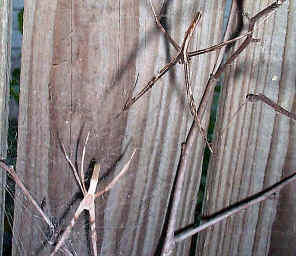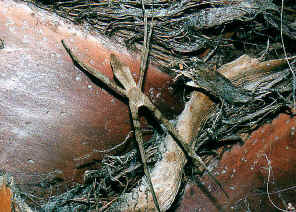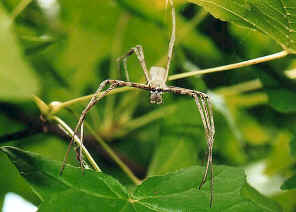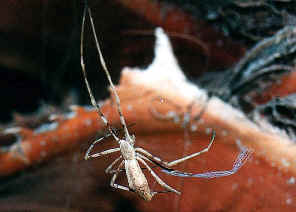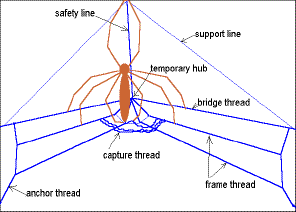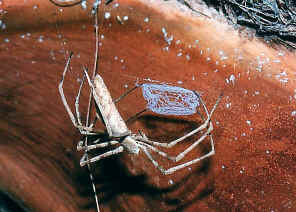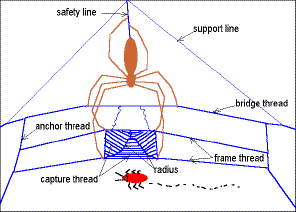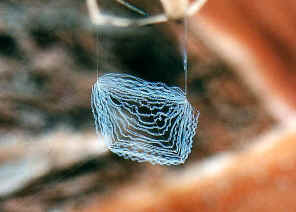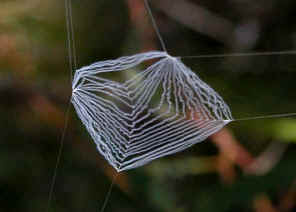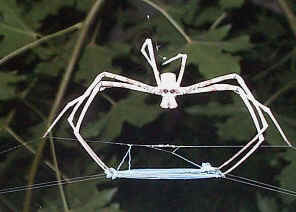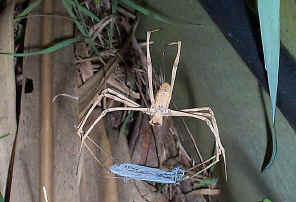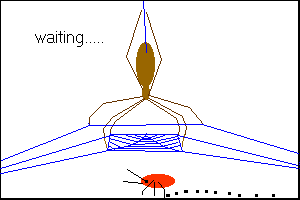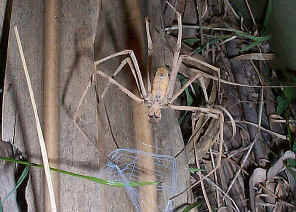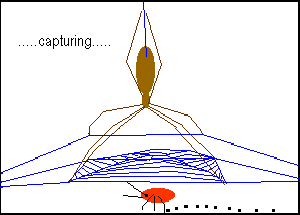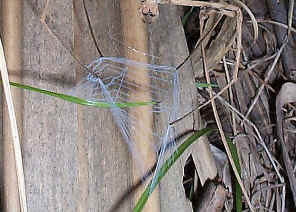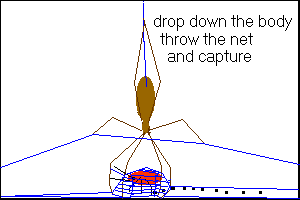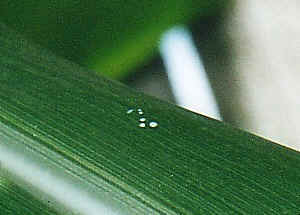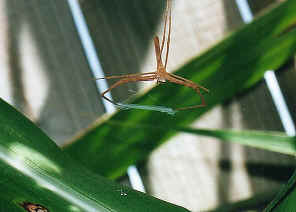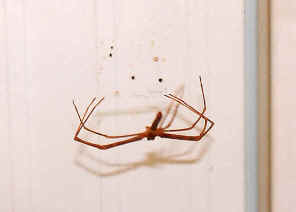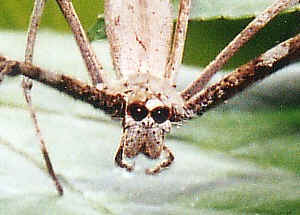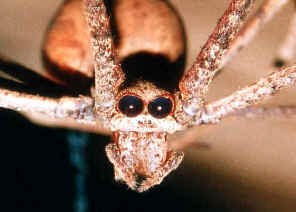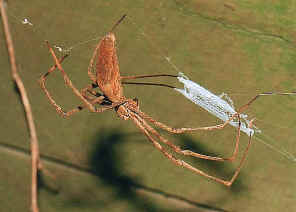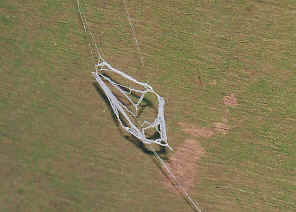|
|
Common Net-casting Spider - Deinopis subrufa
FAMILY DEINOPIDAE
This page contains pictures and information about Common Net-casting Spiders that we found in the Brisbane area, Queensland, Australia.
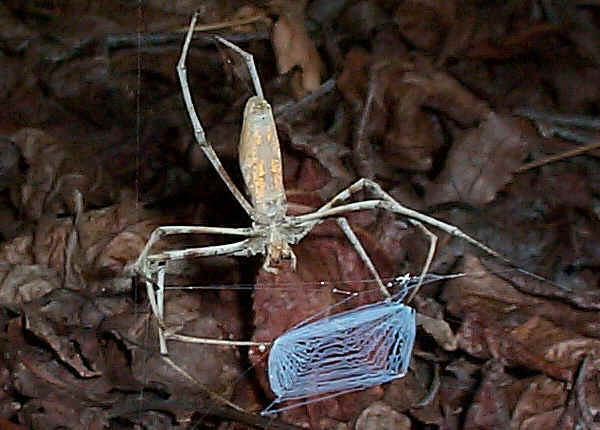
- Female, leg to leg 60mm
Common Net-casting Spiders also are known as Stick Spiders, Web-throwing Spiders and Ogre-face Spiders. They are large and slow moving spiders. The spiders have long body, up to 30mm, and stick like legs. Their slender bodies are light brown or grey in colour. As most other spiders, they have eight eyes, two of which are enormously enlarged and face forwards, looking like two searchlights.
In Brisbane Common Net-casting spiders can be found in bushland and gardens. The spiders rest during the day, hanging from vegetation with head downwards, their long body and long, thin front and back legs held together on each side, giving the spider a stick-like appearance. The spiders are active at night, however, we sometimes find them wandering among plants during day time. At night, they are hiding in the middle of the plants over leave or ground ways waiting for prey.
Net-casting Spiders do not build permanent web, instead, they hold the net, which is made of thick, bluish-white cribellate silk, and throw it towards their prey. Their prey can be ants, beetles, crickets and other spiders.
Female and Male look quite different
Female and male Net-casting Spiders look different. For other species of spider, usually the females are larger than male. But female Net-casting Spiders are smaller than the male, although females have larger abdomen.
Females are light brown in colour. There are two humps midway on each side of abdomen, and has orange pattern underneath.
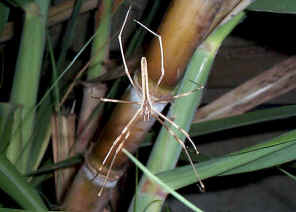
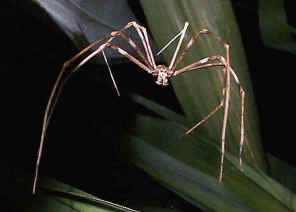
- Male Net-casting Spider, leg to leg 80mm
- Males have shorter and thinner abdomen but with longer legs. There are dark and light grey stripes along the abdomen. On the thorax there are light grey 'V' shape on the head over the eyes.
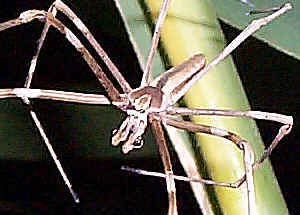
The male Net-casting Spider has the thinner body and proportionately longer legs. After his final moult, the male's only interest is to find the female. Notice its club-like pedipalps in the photo, he will use them to hold and transfer his sperms to female during mating.
Reproduction of Net-casting Spiders
Net-casting Spiders mature in late summer, when mating and egg-laying occurs.
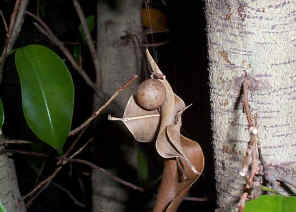
- Egg sac, 10mm diameter
- The egg sac of Net-casting Spiders are brown in colour with dark brown spots. The egg sac usually surrounded by dry leafs and hanging by silk deep in the middle of a thick plants. The above photo was taken in later summer. It was about one meter above ground. The spiderlings emerge in spring.
Net Construction
The Spiders employ an extremely interesting method of web manipulation for catching prey. They do not build permanent web, instead, they hold the net and throw it towards their prey. The Spiders start to build their nets just after sun set. They take about half an hour to build their nets. If the net is used or damaged by any reason, such as interrupted by the observer, they will build another one.
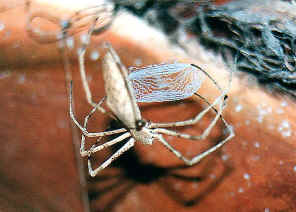
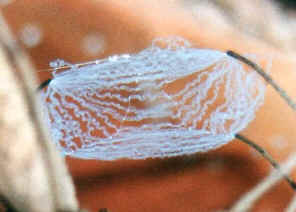
- The spider starts to build the net and finishes after half an hour. The net is a blue-white square of wool-like cribellate silk, those coiled lines are not adhesive but to entangle prey. When stretched, the net can be four to six times larger.
The spider starts with building the web construction over an area, usually above a surface across which prey animals are likely to walk, such as a broad leaf , a tree trunk or a fence wall. The spiders lays the bridge thread, anchor threads, frame threads, the support lines and form a temporary hub as shown in the diagram.
The spider then use a comb-like structure of its hind legs to comb out capture silk from a special silk-producing organ under it abdomen. The meddle of the frame threads form the radius. The capture silk is combed out onto the frame frame threads and radius.
After putting the all the capture thread, the temporary hub is no longer necessary and the spider just removes it. The spider also breaks the safety line from the net and secures the bridge thread, Then the net is ready, the spider moves with the head facing down, holding the net by the four corners with its four front legs and then waits for prey. The web construction is very stable. The spider and the net will not move or swing even in strong wind condition.
The capture silk looks like as it is in a relaxed form, like a relaxed rubber band. The capture silk is not adhesive but will entangling the prey. The first picture shows the just finished net, before the spider holds it with four front legs. When the spider first hold the newly built net, the spider will stretch the net a few times to make sure the net is perfect. Then start to wait for prey.
The above picture was taken at the prey's point of view. Imagine if you were the small cockroach walking under a Net-casting spider's net. Look up and this is your last sight.
Prey Capturing
The following pictures show the stages of the Net Casting Spider hunting sequence. After the spider weave the net. It holds the net by first two pairs of legs. It hangs up-side-down, holding the safety line by last pair of legs, waiting for prey walking within range.
When a prey passes under it, the spider suddenly jumps down and throws its web over its prey. Notice the spider's waiting posture. The frame threads and the bridge thread are pre-tensioned. By releasing the safety line and pulling the bridge thread, the jump down speed can be lightening fast.
The spider pull itself forward, stretching the net further and suddenly releasing the tension. The net contracts and entangle the prey. Once captured, the prey is then tied up further with more silk.
- The photos show the spider captured the grass tip, which we used it to mimic an insect when taking the photos.
Targeting System
Sometimes the spiders will put a few small dots of white droppings on the surface just below them, such as a leaf or branch. They may use these spots as a target. The spider hangs head-down holding the corners of their web in their front legs. When they see a wandering insect pass over the white target spots, they drop downwards with the net and entangle the prey.
We sometimes find this white markings on the leaf, under the Net-casting Spider nets. We believe they are made by the spiders and at least this can serve three purposes.
1. It can be used as the target or trigger signal in the dark: if this is blocked, then throw the net.
2. It could be used as bait. It could be some kind of smelly materials which attach insects. In the day time when the spider is not present, I saw an ant examined those white marks for a few seconds.
3. This can be a territory marking. I find the same spider stays over this mark for many nights.
In the above picture, count how many dots the spider had made on our back door.
Ogre face, large eyes, excellent night vision
There are no movement sensing silk in the Net-casting Spider's web construction. The spider detects prey in the dark by its excellent eyesight, with a huge pair of forward facing eyes.
- Notice the spider's big eyes and large chelicerae form its funny looking face. So they have the common name called Ogre-face Spiders. Their big eyes help them to see in the dark. Although, we found that the spiders do not seem to respond to our torch light.
Like most spiders they have eight eyes, but two of them are extremely large and peer out from the head like searchlights. These large eyes provide outstanding low-light night vision. Scientists found that Net-casting Spiders can see in dark better than cats and owls.
Net Re-cycle
The spider hunts for all night and hides during the day. Just before sun rises, the spider usually eats the net to recycle the silk before sun rises. If the spider is well fed, it may just discard it near by.
Evolution
When we carefully compare the net structure of the Net-casting spider with the web weaved by orb web weavers, we found that there are the high degree of similarity. The web structure and web spinning behaviour tell us that the net is a highly modified orb web and Net-casting Spiders are descended from orb-weaving ancestors.
